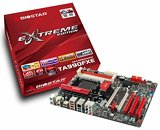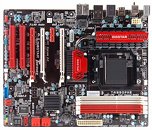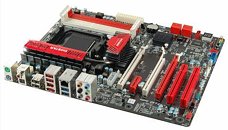Thursday, September 29th 2011

BIOSTAR TA990FXE Socket AM3+ Motherboard Pictured
BIOSTAR is ready with its new performance-segment socket AM3+ motherboard based on the AMD 990FX + SB950 chipset, the TA990FXE. It carries on with the design elements and component choices for some of BIOSTAR's recent Intel Z68 motherboards, it's likely that the board will carry a sweet-spot price. The CPU is powered by a 5-phase VRM, it is wired to four DDR3 DIMM slots, supporting dual-channel DDR3-2000 MHz memory.
Expansion slots include three PCI-Express 2.0 x16 (x16/x16/x4), a PCIe x1, and two PCI. Five of the six SATA 6 Gb/s port from the southbridge are internal ports, with the sixth one being assigned as an eSATA. The connectivity loadout covers essentials: 8-channel HD audio, USB 3.0, gigabit Ethernet, and FireWire, apart from USB 2.0 and PS/2. The board is driven by AMI UEFI firmware, with BIOSTAR's own GUI setup program.
Source:
TechConnect Magazine
Expansion slots include three PCI-Express 2.0 x16 (x16/x16/x4), a PCIe x1, and two PCI. Five of the six SATA 6 Gb/s port from the southbridge are internal ports, with the sixth one being assigned as an eSATA. The connectivity loadout covers essentials: 8-channel HD audio, USB 3.0, gigabit Ethernet, and FireWire, apart from USB 2.0 and PS/2. The board is driven by AMI UEFI firmware, with BIOSTAR's own GUI setup program.



22 Comments on BIOSTAR TA990FXE Socket AM3+ Motherboard Pictured
Not to sure on the 5 phase vrm though
Are they actually decent?
I haven’t heard if Biostar is better today, but I heard so many horror stories from 2-3 years back I just don't even consider them. I had a MSI "Business Class" that bubble a capacitor, and that was pretty much after the "bad cap" time.
ASUS > Gigabyte ≥ AsRock. The last AMD builds where 870 Gigabyte and AsRock, both have been perfect.
Biostar has come long way, their customer support is far better than any tech company, RMA system is easy, turn around time is 7 to 14 days. When they receive a 'defective' product they really test it and if possible fix it and ship it back not like the dead 'Abit' brand. I would defenitely look into this board if the price is right.
The best you can get on a 990FX board is 8 phase, as far as I know. And it ranges from 4 to 8 depending on the board and manufacturer. I'm assuming that's part of the AMD chipset spec.(?)
All that screams 'buy me you dumbass overclocker!" and "More Sata ports? 8 phase? These aren't the features you're looking for...move along."
There's no difference in normal operation. More phases mean more power and more heat, yes.
More phases allow for stable operation if there is a spike in power draw; something that can happen with an overclocked cpu. 4 phases operate normally, but when there is a power spike, the others kick in to provide power.
That's pretty basic stuff, but maybe I misunderstood your sentence.
I still don't understand why some Intel boards are tricked out with 12/16/18/24 phases... other than to guarantee longer term reliability with crazy overclocks?
Biostar boards are relatively cheap, and although this 990FX board is being marketed at gamers, there's no guarantee that the 5 phase VRM is quality parts. Also 5 phase would mean 4+1, 4 for cpu and 1 for IMC.
Either way you look at it, many low quality phases vs few high quality, or higher quality phases in larger number for better overclock stability and performance, 4+1 phase power is a cost cutting measure. You're losing reliability, because there's no guarantee that you won't have a faulty component(s) that might fail and cause instability.
Edit 1:
In addition, I know that ASUS does use a VRM setup like I described, in their Sandy Bridge boards; 4 phases in normal usage, additional phases kicking in when needed. They even have an option in their UEFI that allows for rotating usage in blocks of 4, so that components do not wear out.
Now, in general, I agree with you, but since board manufacturers don't advertise (in detail) how their VRM functions (unless you ask or talk to a knowledgeable product rep...) and since high end AMD boards always come with 8+2 phases (or more?), there has to be more to it than that. I'm not saying that the boards are using higher than spec. current... a cpu isn't going to be constantly drawing max power unless you're dumb enough to turn off everything in the bios and run megagigahertz 24/7...
Edit 2:
Further reading suggests to me that the 8+2 phase designs are 4+4+2; 4+1 redundancy or 4 phase cpu redundancy +2 phase IMC. Reliability.